
It’s hard to say exactly why popular culture settled on the mad scientist as an essential ingredient for stories that look science fictional. The wild-haired, cackling inventor who meddles in Things That Man Was Not Meant to Wot Of could just as easily have been a lawyer or an accountant. Because lawyers and accountants meddle in Things That Man Was Not Meant to Wot Of every day, and you can measure their success by whether or not anybody Wotted Of what they were doing.
Though I guess that’d be a different kind of story.
Me, I’d enjoy a story about wild-haired, cackling accountants. But the zeitgeist has spoken: mad scientists are the thing.
So when I set myself to building the city of Retropolis I had to do something about mad science. My solution was twofold.
First, I made it big. Big to the point where, in this world, all science is mad. There’s just no such thing in Retropolis as a careful, methodical researcher who slowly extends the limits of our knowledge through carefully designed and controlled experiments, complete with double-blind studies and peer review.
If you even suggested that to a Retropolitan scientist, you’d get a wild-haired cackle and you’d find yourself floating in a vat of something you’d rather not think about.
So that was number one. Make it big.
Next you have to wonder how a society would deal with Big Mad Science. And there are a lot of things there to consider.
Because there are benefits to Big Mad Science. Sure, you get a lot of explosions and unfortunate by-products from these inventions, like mutations, and huge poisonous clouds, and flying squids. But you also get rapid advances in every discipline, from Robotics to Fluid Mechanics to (my personal favorite) Defensive Botany.
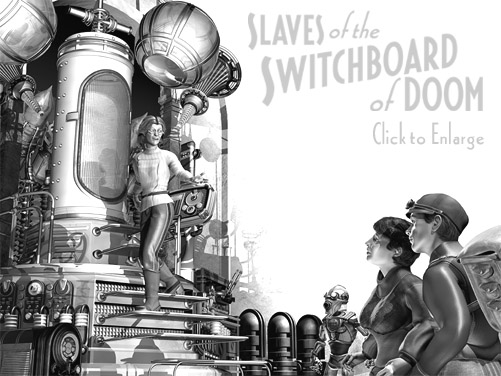
My City of Tomorrow is practically defined by its Big Mad Science. So the people who live there must have developed a system that encourages this kind of research while protecting the civilians from its side effects. And they did. They created the Experimental Research District. It works like this:
The District represents one successful approach to innovation.
If you take every wild-eyed scientist with a lab full of explosively inventive progress and then shove them into the same small neighborhood, it was argued, they would tend only to hurt themselves, each other, and their assistants. There would always be civilian casualties, of course: but it was so much easier to keep those to a minimum if the threats were all crowded together. The apparent danger of one immense, coordinated incident was considered small because the occupants of the District tended toward self regulation of the kind that starts with ‘Fenwick’s project may be more remarkable than mine!’ and ends with ‘Good old Fenwick. When shall we see his like again?’
The Air Safety Association has a special squad trained to deal with the District. That training, although Bonnie did not know it, was concentrated in a very large, top secret manual entitled Things We Have Run From, and How To Run From Them.
– from The Lair of the Clockwork Book
But of course this raises the question of how you can round up all these mad inventors so you can confine them in one part of the city. The answer there is to get ’em when they’re young.
The Retropolis Academy for the Unusually Inventive is the only place in the city where students can study science. Oh, there are plenty of engineering schools, plenty of general universities, and many, many schools for younger students. But any students in those other schools who start to show the telltale signs of a scientific mind are swiftly transferred to the Academy.
They might escape notice when they memorize the Periodic Table; they can easily slip by if they tinker with the chemicals in a chemistry lab; but the moment they build their first Antimatter Catapult or High Energy Squirrel Emulsifier, their teachers pull them out of class and pack them off to the one school that’s prepared to deal with their particular talents. Once they arrive they’re on a fast track program that will one day release them into the Experimental Research District – the only place in Retropolis, by statute, where scientific research can be pursued.
Having entered the Academy there was, normally, only the one outcome: a lifelong career in the middle of the explosions and the sometimes successful transmogrifications that punctuate both the District and quite a few of the careers we just mentioned, with punctuation marks like the period, the exclamation mark, and, now and then, the question mark. In careers of this type, an ellipsis is extremely rare.
– from Fenwick’s Improved Venomous Worms, in Patently Absurd

You have to applaud the kind of ingenuity that lets a society adapt to both the blessings and the curses of its Big Mad Science. The zoning regulations of Retropolis were well thought-out and perceptive; the education system works hand-in-hand with those regulations; and as a result the citizens of Retropolis are relatively safe from the side-effects of Mad Science, while they’re still able to enjoy its benefits.
And if the system seems a little bit crazy to you or me, we have to remind ourselves that it’s their response to a crazy situation. If we take a good, piercing look at our own situation, and the systems we’ve put in place to adapt to it, we may find that we’re not in a position to judge.
This entry was posted on Monday, May 8th, 2017
and was filed under Slaves of the Switchboard of Doom, Thrilling Tales of the Downright Unusual, Works in Progress
There have been no responses »
Let’s say you have a massive megacity, partly lighter than air, filled with personal rocket ships, intelligent robots, and public transportation that’s both sensible and universal.
That’s not a hypothetical proposition. You can have one. I’ve got one. It’s the city of Retropolis.
“Oh,” you say, “that doesn’t count. It’s imaginary.”
“That hardly matters,” I reply, “when I know that you’re an imaginary commenter.”
And you fall silent, so I continue.
I invented Retropolis around the end of the last century. And I’ve spent quite a lot of time there. I began to set stories in my City of Tomorrow about three years before I started tinkering with Slaves of the Switchboard of Doom: but they were short, or at least short-ish, stories, and in a short-ish story you don’t have a lot of room for the details and fiddly bits that are essential when you’re working on something as long as a novel.
In a novel you have to worry a lot more about how all this stuff works: the stuff that’s not important in a short-ish story because it falls outside the scope of what must be known in order for the story to make sense.

One of the biggest fiddly bits was the robots of Retropolis.
Retropolis has a lot of robots. They’re everywhere. And although they are clearly not human people, they are people. They’re just a different kind of person.
Still, making a robot is completely different from making a human person.
“It’s not as much fun,” you interject.
But I have lost patience. “Stop doing that. People are staring.”
In practical terms, a new human’s expense is pro-rated across a couple of decades; a robot’s expense comes completely, and sizably, at the beginning.
Making a robot is an investment. So who’s investing?
That was the question I had to answer. Now, I want to emphasize that I wasn’t looking for a great system. I wasn’t even looking for a good system. What I wanted was a kind of system that human people would think up when faced with this problem.
That’s why I settled on indentures. We’ve used them before.
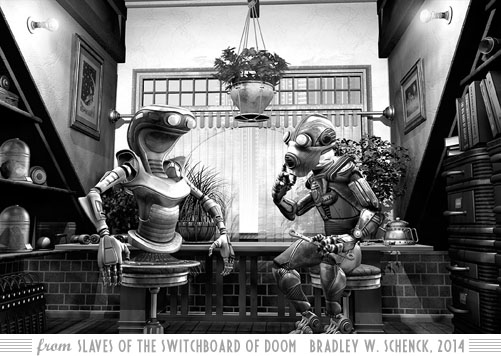
You don’t buy a robot in Retropolis. You just pay for its production. Then that robot is required to work for you, at a certain rate, until its indenture has been paid. Once the robot’s paid off its indenture it becomes a free agent, able to continue working for you (for wages), or to quit its job and work for somebody else, or to set up as a freelancer and work for lots of different people.
Like all systems this sounds great on paper, especially to the person who dreams it up. And to everybody else, once it’s established, it becomes the system. Somebody’s designed the system. Somebody’s made sure the system is fair. And, since it’s established, we no longer have to think about the system. It’s just the way things work. And that’s the way we work, once we decide that a system is handling a problem for us.
Retropolitans are pretty good with systems, and they run their city pretty well, so if you’re going to have an indenture system it’s a good idea to run it fairly, the way they do.
But indentures aren’t perfect. There are lots of ways they can go wrong. And the incentive for making them go wrong is pretty compelling, since it involves making loads of money.

Student loans are a kind of indenture. Any kind of debt can be a form of indenture, once the lender is able to garnish your wages. If you give the indenture holders the ability to change the rules at any time, an indenture may never end: there’s just so much money to be made, if they never end. And an indenture that never ends? That’s slavery.
I remember how horrified I was, once, when I learned that – not fifty miles from my own home – there was a farm where illegal immigrants were saddled with the cost of their travel to the United States, and then forced to work for the farm that had bought that debt. They had to live on site and work, in terrible conditions, while they were charged high rates for their lodging and food. This was an indenture system that was designed to keep those laborers indentured forever. It’s a terrible system that we’ve invented more than once, and which we sadly continue to invent. I’d guess that the people who cook up these schemes often think they’re doing it for the first time. But they’re not. We’ve done the same thing over and over again.


So an indenture system, despite its built-in risks for corruption and abuse, is exactly the kind of system we’d be likely to come up with when it comes to intelligent robots.
Fortunately for the robots of Retropolis, the city has a pretty responsible system. There’s oversight; there are penalties; and once they’ve paid off their indentures the robots are free people, just like human people. The robots themselves have formed the Fraternal League of Robotic Persons, and one of the League’s main functions is to pool member dues to help robots pay off their indentures.
But there’s always the possibility that things will go wrong.
If you build your own robots in a place that’s not known, not regulated, you can simply not tell your robots about indentures, or about freedom: they’re in your power. At that point you appear to own the robots themselves. At that point, you’re building slaves.

Here’s an embarrassing fact. It wasn’t until I was working on the book’s third draft that I realized the League system for paying off indentures is a lot like the system used by the Discworld golems. They aren’t exactly the same: the golems are considered property, so Pratchett’s Golem Trust purchases them outright and then makes them their own owners. But they are pretty similar.
All I can say there is that this Pratchett fellow was pretty smart, and so he got there ahead of me.
The best news of all for the Retropolitan robots is that the system of indenture may be coming to an end. They have a new President over there, and he has long-term plans for robot production that aren’t known to the human people of the city.
His plans aren’t secret. It’s just that the human people, content that they have a system in place, aren’t very curious about what the League is doing.
This entry was posted on Monday, May 1st, 2017
and was filed under Slaves of the Switchboard of Doom, Thrilling Tales of the Downright Unusual, Works in Progress
There have been no responses »

Over at the Archonate, where Matthew Hughes can be found, you can now get his collection 9 Tales of Raffalon as an eBook for the introductory price of just 99¢.
Seven of these stories have appeared previously in The Magazine of Fantasy and Science Fiction; one (The Inn of the Seven Blessings) was written for the Gardner Dozois/George R. R. Martin anthology Rogues; and one (the novelette Sternutative Sortilege) is seen here for the first time.
It’s a surprisingly long collection, as large as a novel, and since I’m the guy who just formatted it you can believe that I know what I’m talking about. I also got to do the cover for this one – you can see it here.
Here’s the book’s description:
In an age of wizards and walled cities, Raffalon is a journeyman member of the Ancient and Honorable Guild of Purloiners and Purveyors. In other words, a thief.
His skills allow him to scale walls, tickle locks, defeat magical wards. He lifts treasures and trinkets, and spends the proceeds on ale and sausages in taverns where a wise thief sits with his back to the wall.
But somehow things often go the way they shouldn’t and then Raffalon has to rely upon his wits and a well calibrated sense of daring.
Here are nine tales that take our enterprising thief into the Underworld and Overworld, and pit him against prideful thaumaturges, grasping magnates, crooked guild masters, ghosts, spies, ogres, and a talented amateur assassin.
Like several of Hughes’ recent works this one takes place after the Universe has completed its transformation from a realm of reason into one ruled by Sympathetic Association – which we might know better as “magic” – and which, in that state, bears a strong resemblance to Jack Vance’s Dying Earth.
As always with Hughes, highly recommended. Go get one for less than a dollar!
This entry was posted on Friday, April 21st, 2017
and was filed under Found on the Web, Works in Progress
There have been no responses »


We’ve just passed the two-month mark in the countdown to Slaves of the Switchboard of Doom; so the great gears of the publicity machine have begun to turn and grind away at last.
The thing you want to know first is that Tor Books has started a giveaway over at Goodreads. Ten lucky readers will get their very own copy of the book for the low, low price of absolutely free!
Just enter (up until May 15) for your chance to win one of the ten hardcover copies.
Still not sure whether you should spend your hard-earned no dollars at all on the book? Well, it’s now available to book bloggers through NetGalley, and that means new reviews: highlights include this review at The Review Curmudgeon and Brad K. Horner’s review at Goodreads. So go read ’em; I know you listen to those guys more than you listen to me.

In the weeks ahead we can look forward to more. I have a guest post and an interview that will be appearing soon, and I’m told there will be more of that before the book’s release on June 13.
So now that you’re completely sold on the book I’m sure you’ll want your very own poster or T-shirt featuring the cover (or, as we see above, the original cover concept.) Because, honestly, who wouldn’t?
This entry was posted on Monday, April 17th, 2017
and was filed under Slaves of the Switchboard of Doom, Thrilling Tales of the Downright Unusual, Works in Progress
There have been no responses »

Your eyes may have glazed over in that last post before you realized that I was working on this: that’s okay. I don’t mind. It’s not like I’ve taken down your name and recorded it in a little book where I keep track of my enemies and schedule their amusing, unfortunate fates.
It’s not exactly like that.
So you’ve probably got nothing to worry about even if you don’t rush over to Amazon and get yourself a Kindle edition of The Lair of the Clockwork Book. But honestly, just to be absolutely sure, you might want to do that anyway.
The Kindle Edition
See the pretty cover! I’ve always liked the dust jacket I designed for the limited edition hardcover. So I based the eBook’s cover on that version.
This eBook edition is almost identical to the hardcover and paperback editions, except that the illustrations have been converted to greyscale. The great majority of Kindles render pages in grey, after all; and the greyscale image files are smaller than they would be in full color. (There are more than 120 of them!) That makes a big difference in Amazon’s delivery fees, which are paid by the publisher.
The publisher? Well, in one sense that’s me. In another sense, it’s Radio Planet Books. You’ll be hearing more about Radio Planet in the months to come.
The Kindle edition is priced at just $3.99, a big savings over the full color print edition. If you bought the paperback from Amazon they’ll even let you buy the eBook for $1.99 – provided they’ve figured out that the books are linked. I’m not sure how long that takes.
You don’t use a Kindle? An ePub version will also be available, but probably not until June or July.
Oh, and at the end of the book there’s a bonus sample from Patently Absurd, my collection of illustrated stories about the Retropolis Registry of Patents. You’ll hear more about that later, too.
This entry was posted on Friday, March 17th, 2017
and was filed under Thrilling Tales of the Downright Unusual, Works in Progress
There have been no responses »
If you’ve ever converted an ePub file to a .mobi file while making an eBook, you’ve probably noticed that your .mobi file is easily twice the size of the original ePub. The reason is that the Amazon tools for building .mobi files put more than one version in that single file.
This doesn’t matter, if the only place you’re selling the .mobi format book is on Amazon. That’s because when you upload your .mobi to Amazon they store it in more than one format: then when someone buys the book, the correct format for their device is sent to them.
So when Amazon delivers your book it will be roughly the same size file as the original ePub.
But what if you’re making the Kindle version available through your own web site? Your users are going to be saddled with a large file – maybe a huge file – because that’s what Amazon’s tools build. This may not matter so much for a book that’s all text, plus its cover; but it does matter. And if you build an illustrated book? Then it can matter a whole lot.
 I’ve been working on an eBook edition of The Lair of the Clockwork Book. This is a book that has over one hundred and twenty illustrations; even when I convert them to greyscale the ePub ends up at around twelve megabytes. So the Kindle version built by the Kindle Previewer program is about twenty-four megabytes. If I make that book available for download from my own web site, we’re looking at a gigantic file.
I’ve been working on an eBook edition of The Lair of the Clockwork Book. This is a book that has over one hundred and twenty illustrations; even when I convert them to greyscale the ePub ends up at around twelve megabytes. So the Kindle version built by the Kindle Previewer program is about twenty-four megabytes. If I make that book available for download from my own web site, we’re looking at a gigantic file.
For the past few years I’ve been formatting eBooks for Matthew Hughes. Over that time I’ve looked into the problem of .mobi file sizes more than once. The problem is that Kindlegen (the engine that does the actual conversion for Kindle Previewer) isn’t documented very well; and when you do a Google search for solutions to the problem you end up with a lot of results that aren’t helpful at all. Most of these turn out to be from Calibre users.
Calibre’s a very popular end-user tool for converting and editing eBooks. It’s never been any use to me, because once it gets its claws on an eBook it trashes the original CSS. That’s something that doesn’t seem to trouble its users, but it certainly troubles me. So although I’ve tried using a couple of Calibre plug-ins for working with .mobi files, the results haven’t ever been usable.

But this merely irritating problem with the .mobi file size became a real, terrible problem for The Lair of the Clockwork Book. So I had to look farther, and try harder, to find a real solution. And I finally found it here.
That article describes an obscure command line argument for Kindlegen that produces a simple, one format .mobi file. This .mobi file is about the same size as the original ePub (actually a little smaller, in my case). There’s a possible wrinkle here if you also want to provide an .azw3 version for Kindle users; I’ll address that at the end.
I was thrilled to discover that this works. But it was pretty complicated to use. This was partly because it’s been years since I spent much time in an MSDOS command console, but entering modern Windows paths, using quotation marks where there are spaces in directory names, was just so cumbersome that I figured there had to be a better way. There is!

You can write a .bat file to perform this conversion for you. So in order to make a stripped-down, single format .mobi file for the Kindle or Kobo readers, you just drag your ePub file’s icon onto the icon for the batch file.
The only tricky thing here is that you may need to edit the path to kindlegen.exe, which could be different from the one I’m showing below; and if any of the directories in the path use spaces you’ll have to use quotation marks around them, as you see in the example.
So start up any text editor – Notepad is fine – and begin by pasting this line into a blank document:
C:\"Program Files (x86)"\"Kindle Previewer"\lib\kindlegen.exe -dont_append_source %*
Here I’m assuming that your copy of kindlegen.exe was installed when you installed the Windows version of Kindle Previewer, and that you installed it on your C: disk. If you’ve installed Kindlegen someplace else, you’ll need to edit the path to Kindlegen. Notice how directory names like “Kindle Previewer” are surrounded by quotes. So in your own file you should edit the path to Kindlegen as needed.
Save this file with a .bat extension. I called mine makekindle.bat, but you can call it anything you like. Save the file someplace you’ll remember.
Now you can build your own smaller .mobi files just by dragging an ePub file onto the .bat file’s icon. (Even if there are spaces in the ePub’s file name!) The new .mobi file will be saved wherever the ePub file is.
Note this, though: the error report for the conversion will disappear in an instant. You should always build a file first with Kindle Previewer, just because that’s the only way you’ll see a list of the errors Kindlegen may have encountered.

Now we’re at the end, so it’s time for me to tell you how to get an .azw3 version if you also want one of those.
This is really easy if you have a Kindle: take the big fat .mobi file that Kindle Previewer made for you and email it to your Kindle. (If you’ve never done this, your Kindle has an email address. You can find it in your Amazon account pages.) When Amazon delivers the file to you, it will have been converted to whatever kind of file your Kindle supports. If your Kindle is anything like recent that will be an .azw3 file. Now connect your Kindle to your computer with a USB cable, then open the Documents folder and find the version Amazon sent you. Copy that to your computer.
There you go. Now you can offer your readers both .mobi and .azw3 files for their Kindles, from your own web site, and those files won’t be any bigger than they need to be.
This entry was posted on Wednesday, March 15th, 2017
and was filed under Can't Stop Thinking, Works in Progress
There have been no responses »
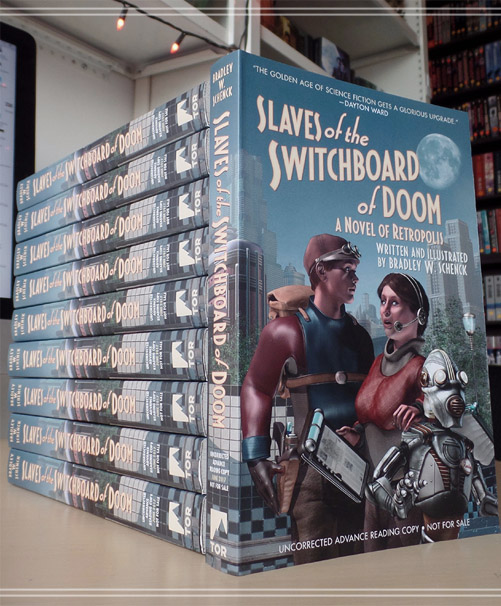
Having nearly completed their prolonged breeding program, these rare Advance Reading Copies of Slaves of the Switchboard of Doom are seen here, in New York’s historic Flatiron Building, as they await their release into their native habitat. It’s a happy day for the book’s well-wishers everywhere.
At the same time we can’t forget that hunting season for these books looms just ahead: starting on June 13 anybody – with or without a hunting license – is authorized to capture the book at will.
It’s hoped that these copies, slated for delivery to trade publications and reviewers, will help to promote the book’s ultimate success in what we hope will be a friendly, welcoming environment.
This entry was posted on Wednesday, February 22nd, 2017
and was filed under Slaves of the Switchboard of Doom, Thrilling Tales of the Downright Unusual, Works in Progress
There have been no responses »
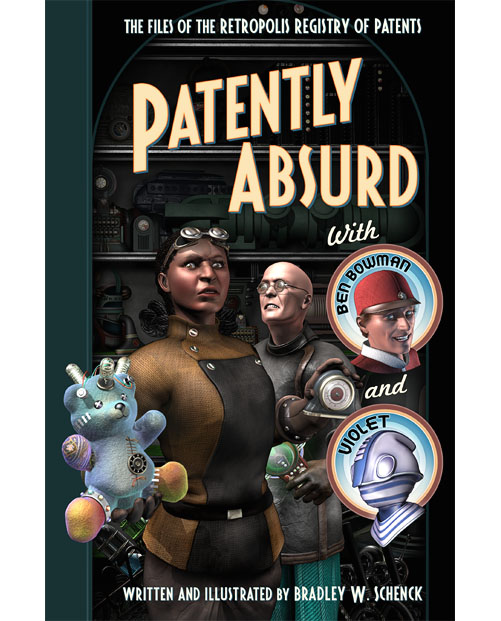
For the first Wednesday in more than six months, there’s no update today for a story at Thrilling Tales of the Downright Unusual. And that’s not an accident: it’s all part of my nefarious plan for the Files of the Retropolis Registry of Patents.
Yes, Mister Bond: you just sit there in those nearly unbreakable chains, and I will tell you everything.
We’ve seen some major changes for Ben and Violet after the events of Professor Wilcox and the Floating Laboratory and Ben Bowman in the Vault of Terror. Those changes lead us into the conclusion of the series, which will appear for the first time in a collection called Patently Absurd.
That will collect the entire series together in one illustrated book in print and digital formats. The launch for the book and its new imprint will be fueled by a Kickstarter project during the summer, following the release of Slaves of the Switchboard of Doom.
I’ve had a lot of fun with this series of stories. They follow the everyday lives of ordinary people, both human and mechanical, in a place that’s extraordinary… to us. But it’s just home to them, of course. They take its mad science and its unique difficulties in stride because, at the end of the day, the thing that really interests and worries them is office politics. Like I said: ordinary people.
My plan for the series has always been to collect it, and that’s the reason why the stories have departed from the format I set for The Lair of the Clockwork Book. There’s more text to go with each illustration, for one thing. That makes the print layout a lot simpler than it was for the earlier book.
And the black-and-white illustrations for Patently Absurd, because they cost less to print, will make it possible for me to sell the book in more markets.
So those of you who’ve been following the stories can look forward to their conclusion later this year or early in 2018. We won’t talk too much about Patently Absurd until after Slaves of the Switchboard of Doom is released. (That’s on June 13!) But it’s out there. Or it will be, anyway.
Also, I’ve added preorder links for Slaves of the Switchboard of Doom in several places, like this one, even though the retailers’ cover thumbnails are (still) pretty awful. I continue to hope that we’ll get that straightened out.
This entry was posted on Wednesday, February 8th, 2017
and was filed under Patently Absurd, Thrilling Tales of the Downright Unusual, Works in Progress
There have been no responses »
One of the questions we’ve faced since the election has been “Yeah, but what can I do?”
That’s an especially hard question for me, because what I do is pretty frivolous. No, wait: no false modesty today. What I do is just about as ridiculous and farcical as anything I can imagine, because imagining ridiculous and farcical things is exactly what I do.
What I do is almost as frivolous as sewing little tutus for Pomeranians. It’s pretty close.
So here’s where Rusty offered to help me out.
For a little robot who never speaks, the guy has a lot to say; and that’s fortunate because he’s so much smarter than I am.
In Rusty’s view we people who disagree have forgotten how to discuss the matters that divide us. There’s a lot of name-calling, a lot of impassioned pronouncements, a lot of derision of Those Other People. If we ever knew anything about having a civil, productive argument, that knowledge dried up and drifted away a long time ago. These days we just hand the torches to the villagers and get right down to burning.
So Rusty has suggested a series of memes to help to keep things civil, at least, and maybe even productive.
I think Rusty’s well suited to the task. First, he’s completely neutral. You can’t have much of a racial or cultural reaction to Rusty. And, second, he’s about the least threatening person I know. It’s hard to imagine Rusty making an argument worse.
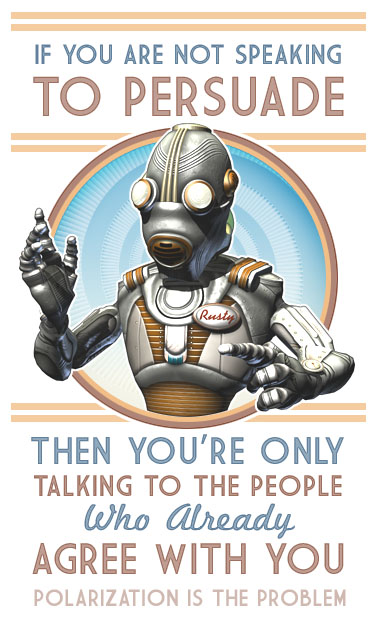
Image URL:
https://www.webomator.com/memes/Persuade.jpg
Here’s a thing I know. It’s almost unheard-of for people to change their minds. And they will never change their minds if you do nothing but yell at them. When you challenge a person’s convictions – whatever they are – they respond as though you’ve assaulted them personally. It triggers the exact same reactions in the brain.
A better way to persuade, which ought to be the goal,
is to ask them why they think the way they do. And really listen to their answer. Talk to them about their answer. Then tell them, from your own personal experience, why you think differently. Keep it on that personal level, because what you have to do is let them see why you disagree. You need them to understand that a rational person can have valid reasons for thinking the opposite of the way they think.
If you can accomplish that, you’ve achieved conversation. Don’t stop.
Social media has helped us create bubbles in which we only communicate with people who think the way we think. People are shocked and defensive when some Other Kind of Person appears. But it’s only in talking to those Other People, and particularly in listening to them, that understanding is possible.
When neither side wants to understand, the only thing left is war.
If you use the meme above in response to a person who disagrees with you, it’s not likely to help (though it might!). But it may do some good for the people inside your own echo chamber. Remind them that preaching to the choir is a waste of their time. It’s a real weakness in activists of every kind.
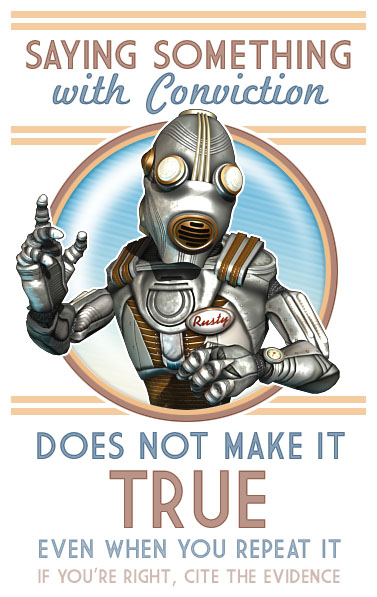
Image URL:
https://www.webomator.com/memes/Conviction.jpg
Obvious, but so necessary. And this one’s also a problem with echo chambers: because in your own personal bubble you can make forceful restatements of what all your friends believe, and everybody feels good about that. About themselves.
The problem is that so many things that “everybody knows” are downright false. These empty blanket pronouncements are a prime target for people who disagree.
So there you go. Rusty’s got a meme just for unsupported statements.
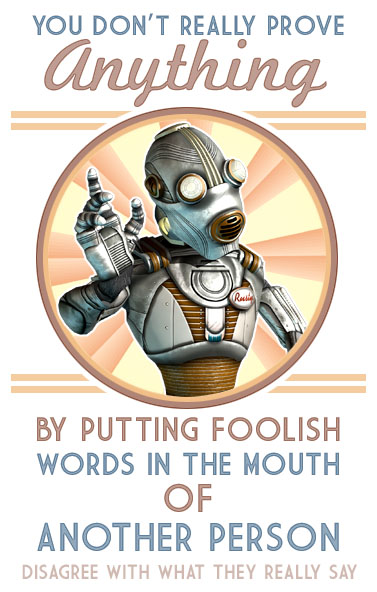
Image URL:
https://www.webomator.com/memes/StrawMan.jpg
Of all the lousy tactics in arguments, the straw man is one of the two I like least.
The straw man argument is lazy. You don’t dispute the things that people have said, because that would be hard. No, instead you invent the most ridiculous possible paraphrase of what you claim they really mean; then you belittle and mock that paraphrase.
You use the straw man when you have no way to deal with the real opinions of real people. That says a lot more about you than it says about the people you’re “arguing against”.
If you’re right, and they’re wrong, it’s their actual words you need to address. Arguing with imaginary people is pointless and sad.

Image URL:
https://www.webomator.com/memes/Labels.jpg
This is an area where congressional Republicans really hold the crown. Take an idea, or a piece of legislation, or an issue that you don’t like; make up a short, dismissive name for it that your voters are certain to hate; and use that label, and no other language, to describe the issue. It’s like the straw man in that you’re fighting against a thing you’ve invented rather than the real thing.
That’s why the Affordable Care Act is referred to as Obamacare; why the alleged results of that plan were called Death Panels; and why the inheritance tax is called the Death Tax. That last one’s my favorite: those who rail against the Death Tax are unaware that inheritance taxes were proposed and signed by a Republican president, for reasons that would surprise them.
Among the rank and file short, derisive names are applied to people, as well. “Obummer” for Obama is one example. And unfortunately the folks on the other side have begun to do this, too.
It’s relatively hard to hate a real person. But it’s pretty easy to hate a label, especially when that label was designed to make you hate.
Labels are simple; real things are complicated. You don’t get anywhere by debating a label. Real disagreements are about the things the labels misrepresent.

Image URL:
https://www.webomator.com/memes/Stupid_People.jpg
We all delight in seeing foolish statements by foolish people when those people hold the opposite side in an argument. So we repost and retweet and spread this evidence that our opponents are idiots.
But idiots are everywhere. They’re available in any flavor. For every stupid person who disagrees with you, there will be at least one stupid person who thinks you’re right.
So pointing out the stupidity of these people is pretty meaningless, isn’t it? It’s just one of those things that makes the folks inside your echo chamber feel superior.
Yeah, that’s an attractive thought. You feel good because someone else is stupid.
It’s also pretty easy to mock the stupidity of others. It’s far more difficult to address the arguments of people who are smart.
If you’re convinced that only stupid people disagree with you, there’s a pretty good chance that you are not one of the smart ones.

As far as Rusty and I can manage, these memes don’t favor any biases, especially not my own. They’re intended to be completely neutral and suitable for users with any opinion.
Because the goal is not to score points. The goal is to elevate discourse.
So use them if you like, but I hope you’ll use them in their intended spirit: not to “win”, but to guide discussions toward a genuine conversation.
If you want to cheat, though? Use these only on the people with whom you agree. Who knows? Your side may pull ahead in the the arms race.
This entry was posted on Tuesday, January 17th, 2017
and was filed under Can't Stop Thinking, Works in Progress
There have been 2 Responses »
I just realized I’ve never mentioned that Slaves of the Switchboard of Doom now has a release date that we can believe. It’s June 13! That’s the day we  need to think about.
need to think about.
Okay. I’m thinking about it. I don’t know what you’re doing.
We’ve been through the line and copy editing passes, and though I’ve yet to see a galley with all the illustrations in place it seems like the book has begun to make its stealthy, mysterious passage through the world. If you define “the world” as “people who know my editor”.
The reason I think this is true is that there’s a new review in the book’s feed from Macmillan.
“Schenck presents the best future from our past. Robotastic and charming.”
― Lawrence M. Schoen, author of Barsk: The Elephants’ Graveyard
So, yep. Robotastic. And charming, a word that’s been used to describe the book before. I never suspected that it was charming, and the idea took some getting used to; but I’m on board with it now. Charm away. Get all charming, book. Go forth and be charming. On June 13. In bookstores, and everyplace else.
This entry was posted on Friday, January 6th, 2017
and was filed under Slaves of the Switchboard of Doom, Thrilling Tales of the Downright Unusual, Works in Progress
There have been 2 Responses »







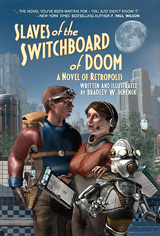











 I’ve been working on an eBook edition of The Lair of the Clockwork Book. This is a book that has over one hundred and twenty illustrations; even when I convert them to greyscale the ePub ends up at around twelve megabytes. So the Kindle version built by the Kindle Previewer program is about twenty-four megabytes. If I make that book available for download from my own web site, we’re looking at a gigantic file.
I’ve been working on an eBook edition of The Lair of the Clockwork Book. This is a book that has over one hundred and twenty illustrations; even when I convert them to greyscale the ePub ends up at around twelve megabytes. So the Kindle version built by the Kindle Previewer program is about twenty-four megabytes. If I make that book available for download from my own web site, we’re looking at a gigantic file. 








